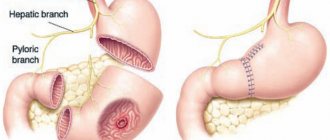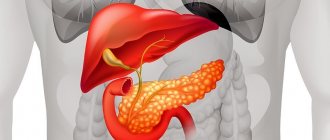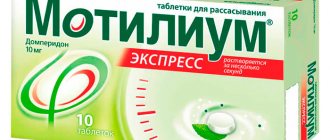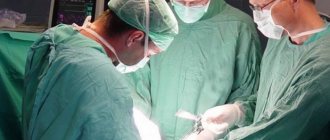Surgeries for pancreatitis are performed when other treatment methods do not produce the desired result. Inflammation of the pancreas in acute form occurs as a result of a violation of the outflow of pancreatic secretions, which leads to the destruction of organ tissue. As the disease progresses and there is no therapy, tissue necrosis and suppuration are likely to develop. When complications of this kind occur, the need for surgical treatment arises. Pancreatic surgery is performed as a last resort, since surgical intervention can have unpredictable consequences, which is associated with the specifics of a vital organ - the pancreas.
The pancreas comes into contact with important organs, damage to which is fraught with irreversible consequences. If necrosis of pancreatic tissue is observed, its removal may be required, and such intervention is often incompatible with life. The secretion of the pancreas can act on it from the inside, causing tissue stratification. During the operation, as well as during the rehabilitation period, there is a risk of heavy bleeding from the pancreatic tissue. Taking into account all the indicated difficulties and risks that arise during the period of surgical intervention, it can be understood that pancreatic surgery is performed in cases of extreme necessity, when the patient’s condition is severe and therapy is ineffective.
What it is
Surgery on the pancreas for pancreatitis, depending on the characteristics of a particular case, can be of a different nature and can be quite complex.
The operation is carried out after clarification of certain factors, specifically the presence of demarcation of damaged tissues from healthy ones, the extent of the prevalence of the purulent-necrotic process in the pancreas, the degree of inflammation and the presence of concomitant gastrointestinal diseases. The surgical method is carried out using laparoscopy, a translaparotomic method of examining the pancreas and abdominal cavity.
During laparoscopy of pancreatic enzymatic peritonitis, laparoscopic drainage of the abdominal cavity is prescribed, and then peritoneal dialysis and drug infusion. The operation is performed under the control of a laparoscope. Microirrigators are applied to the omental foramen and the left subdiaphragmatic space, and a large-diameter drainage is inserted into the small pelvis through a small puncture of the abdominal wall in the left iliac zone.
Dialysis solutions contain antibiotics, antiproteases, cytostatics, antiseptics, and glucose solutions. The method is effective only for the first three days after the onset of acute peritonitis is detected. The method is not performed for fatty pancreatic necrosis, as well as for biliary pancreatitis. Decompression of the biliary tract in pancreatogenic peritonitis is performed by laparoscopic drainage of the abdominal cavity, supplemented by the application of a cholecystoma.
In the case when an edematous form of pancreatitis is detected during laparotomy, the tissue surrounding the pancreas is infiltrated with a composition of novocaine and an antibiotic, cytostatics, and protease inhibitors. For further infusions of drugs, a microirrigator is inserted into the root of the mesentery of the transverse colon. Afterwards, the omental orifice is drained and a cholecystoma is applied. To prevent the entry of enzymes and the spread of toxic breakdown products into the retroperitoneal tissue, the body and tail of the pancreas are isolated from the parapancreatic tissue. If necrosis progresses after surgery, relaparatomy is performed, which is inappropriate due to the large load on the weakened body.
One of the types of disease that requires surgical treatment is calculous pancreatitis, a characteristic feature of which is the presence of stones in the pancreas. When the stone is localized in the ducts, only the wall of the duct is dissected. If there are several stones, then the dissection is carried out along the entire gland. In some cases, complete resection of the organ damaged by stones is indicated.
Currently reading: Names of drugs for intravenous drips for pancreatitis and reviews
When a cyst is found in the pancreas, it is removed along with part of the gland. Sometimes it is necessary to completely remove the organ. When diagnosing cancer, radical treatment methods are used.
The most serious intervention performed for acute pancreatitis is pancreatectomy. The operation is performed with complete necrosis of the pancreas; during surgery, part of the pancreas and 12 rings of the intestine are left.
This operation does not guarantee recovery and improved quality of life, it is traumatic, and has a high percentage of deaths. This method can be replaced by kirodistortion, which is carried out for hemorrhagic pancryonecrosis. During the operation, tissue is exposed to ultra-low temperatures. Healthy connective tissue is formed at the site of exposure. If concomitant pathologies associated with the biliary tract are detected, the use of this method is not allowed, since there is a risk of damage to the gallbladder, 12 rings of the intestine and stomach.
The endoscopic method is used for local complications of chronic pancreatitis, when there is a pseudocyst, narrowing of the main duct of the gland, the presence of stones in the ducts of the pancreas or gall bladder. They can lead to pancreatic hypertension and require endoscopic interventional techniques.
The most popular procedure is sphincterotomy, which is accompanied by endoprosthetics of the main pancreatic duct, and if a stone is present, its removal or lithotripsy, drainage of the cyst. The endoprosthesis must be replaced every 3 months; in such cases, anti-inflammatory therapy is recommended for a year.
The prognosis for the treatment of destructive types of pancreatitis is unfavorable, since there is a high percentage of deaths.
Some types of surgical treatment
This organ causes a lot of trouble for specialists both during and after surgery.
When removing the pancreas, the operation should only be performed by qualified doctors and only when strictly necessary. The following diseases may be considered for surgical treatment:
- organ injury;
- frequent exacerbations of chronic pancreatitis;
- malignant neoplasm;
- pancreatic necrosis;
- acute destructive pancreatitis;
- pseudocysts and chronic cysts.
If there is a pancreatic cyst, surgery involves removing the first part of the organ. As a rule, in this situation, surgical intervention is not considered one of the complex ones.
For stones in the pancreas, surgery begins with dissection of the organ tissue. The walls of the duct are also exposed to this effect. After this, the stones are removed. If there are a large number of the latter, then a longitudinal dissection of the organ is performed, followed by removal of the stones.
It also happens that pancreatic cancer is diagnosed. The operation is the most difficult. In case of tumor of the tail and body, the gland and spleen are removed. In case of a malignant neoplasm in the tail and head, the organ is removed along with the duodenum and spleen.
Surgery against the background of pancreatitis is always a complex and difficult to predict procedure, which is based on a number of aspects that are related to the anatomy of the internal organs of mixed secretion.
The tissues of the internal organs are highly fragile, so the slightest manipulation can cause severe bleeding. A similar complication cannot be ruled out during the patient’s recovery.
In addition, vital organs are located in close proximity to the gland, and minor damage to them can lead to serious disruptions in the human body, as well as irreversible consequences. The secretion, along with enzymes produced directly in the organ, affects it from the inside, which leads to tissue dissection, significantly complicating the operation.
https://youtu.be/hPr2pyPX0m0
Indications for use
With the development of pancreatitis and its transition to a chronic form, disturbances in the morphological structure of the gland tissues appear, in particular, cysts, stones, stenosis of the main pancreatic duct or biliary tract, an increase in the size of the head of the gland as a result of the appearance of inductive or capitate pancreatitis are found. Changes are also observed in the presence of infringement of nearby organs, such as the duodenum, arterial part of the stomach, biliary tract, portal vein and its ducts.
If the above pathologies are detected, hospitalization of the patient is organized. Deterioration of the condition is revealed by increased pain, the appearance of signs of peritoneal irritation, intoxication, and increased amylase in the blood and urine.
The chronic course is characterized by the constant presence of symptoms of the disease as a result of inflammation and fibrosis of the gland tissue. The surgical method is resorted to in the initial phases of the disease if there are signs of peritonitis, severe pain and obstructive jaundice are recorded, as well as in the presence of stones in the gall bladder and ducts. Rarely, the operation is performed when chronic pancreatitis occurs with acute bleeding in the cavity of the pseudocyst or in the lumen of the gastrointestinal tract, or when the cyst ruptures.
Indications for the operation are:
- Reflexivity of abdominal pain to the action of drugs;
- Indurative pancreatitis, when, as a result of a prolonged inflammatory process against the background of reduced organ function, connective tissue grows and scars form, as well as an increase in the mass and size of the pancreas. The condition may resemble symptoms of cancer;
- Non-single narrowing of the main pancreatic canal;
- Stenosis of intrapancreatic biliary tract;
- Incarceration of the portal or superior mesenteric vein;
- Long-term pseudocysts;
- Severe stenosis of the 12th ring of the intestine.
What operations are performed for chronic pancreatitis?
Some patients believe that with diabetes mellitus, along with the concomitant destabilization of the gland due to chronic pancreatitis, only surgery will help. But experts warn that with such a pancreatic condition, one can only hope for relief, and not for a complete recovery without the risk of relapse.
To help victims of the chronic form of such a dangerous disease, doctors have developed several surgical practices:
- drainage of ducts, which is necessary in case of pronounced problematic patency;
- resection with drainage of the cyst;
- resection of the head, which is characteristic of obstructive jaundice, duodenal stenosis;
- pancreatectomy for large-scale lesions.
The stones that are deposited in the ducts deserve special attention. They partially or completely block the passage of secretions, which provokes acute pain. In case of severe pain and the impossibility of reducing its manifestations with the help of pharmacological substances, there is no other option other than classical surgery.
This technique is called virsungotomy. This means cutting the duct to remove the stone, or draining above the level of obstruction.
What is removed
The operation is performed by providing access to the pancreas by making an upper transverse incision. An incision is used to open the abdominal cavity. After opening, the pancreas is isolated by dissecting the ligaments and mesenteries of the intestine, as well as by applying ligatures to nearby vessels. The pancreas is then removed. In some cases, not complete, but partial removal of the pancreas is prescribed.
Currently reading: Level of alpha-amylase in the blood during pancreatitis
For different diagnoses, a certain part of the organ is removed. In most cases, the head or tail of the organ is removed. When removing the head, a Whipple procedure is performed. The procedure is carried out in two stages:
- Removal of the part in which the pathology is localized;
- Carrying out manipulations to restore the digestive canal, the functioning of the gallbladder and its ducts.
The manipulation is performed under general anesthesia. In order to provide access to the pancreas, several small incisions are made through which the organ is examined using a laparoscope.
After this, the vessels through which the gland is fed are blocked and removed. In some cases, neighboring organs are also operated on.
To restore the digestive system, the body of the gland is connected to the stomach and the central part of the small intestine.
If a tumor is detected in the tail of the pancreas, an operation is performed, which is called partial distal pancreatotomy. The tail of the gland is removed, and then the organ is sutured along the cut line. The head of the pancreas is removed only under strict indications, since the operation is quite complex and is fraught with complications and even death during or after the operation.
The most common surgical interventions for acute pancreatitis
Distal pancreatectomy. It involves the removal of the tail and body of the pancreas of varying volume. It is carried out in cases where the damage to the pancreas is limited and does not involve the entire organ. Subtotal resection involves removing the tail, body, and most of the head of the pancreas. Only the areas adjacent to the duodenum are preserved. The operation is permissible only in case of total damage to the gland. Since this organ is unpaired, only a pancreas transplant can completely restore its function after such an operation. Necrosequestrectomy is performed under ultrasound and fluoroscopy control. The identified fluid formations of the pancreas are punctured and their contents are removed using drainage tubes. Next, larger caliber drains are introduced into the cavities and rinsing and vacuum extraction are carried out. At the final stage of treatment, large-caliber drains are replaced with small-caliber ones, which ensures gradual healing of the cavity and postoperative wound while maintaining the outflow of fluid from it.
Preparing for surgery
Regardless of the type of disease, its etiology, form and course, the main and mandatory condition for preparing for surgery is fasting in order to reduce the likelihood of postoperative complications.
The day before surgery, you must refuse any food; cleansing enemas are done in the evening and in the morning. On the day of the operation, premedication is performed to ensure that the patient is put under anesthesia. The purpose of the procedure is to calm the patient, prevent allergic reactions, and reduce the production of gastric and pancreatic juice.
For premedication, tranquilizers, antipsychotics, antihistamines, and anticholinergics are used.
Most patients suffering from chronic pancreatitis are malnourished as a result of digestive disorders. Before surgery, they are prescribed plasma, protein solutions, saline or 5% glucose. If indicated, a blood or red blood cell transfusion is performed in order to normalize hemoglobin levels, prothrombin index, and protein levels.
When a patient experiences prolonged jaundice as a result of a violation of the flow of bile into the lumen of the 12 rings of the intestine, hypo- or vitamin deficiency is recorded. This is due to the inability to convert insoluble vitamin compounds into soluble ones. The process occurs with the participation of bile; the specialist prescribes vitamins parenterally and orally. Before a planned operation, Methionine, Lipocaine and Sirepar are used (intravenously).
What are these operations called?
Various methods are used to restore the outflow of pancreatic secretion and remove necrotic tissue, inflammatory exudate and stop intra-abdominal bleeding:
- Laparotomy and necrectomy. These are abdominal operations. The retroperitoneal space is opened, the pus is aspirated and necrotic tissue is removed; if possible, viable organ tissue is preserved.
- Closed lavage in combination with cardinal necrectomy.
- Endoscopic drainage. There are many options for drainage and removal of necrotic tissue, one of which involves intraoperative widening of the percutaneous drainage channel, performed under CT guidance.
- Puncture is a single injection of a special solution into a necrotic lesion of an organ. This method is only possible with sterile necrosis, without an inflammatory process in the organ.
- Resection and transplantation. Resection is the partial removal of the affected organ. The gland is highly antigenic, which complicates its survival during transplantation. Often the transplanted organ is rejected 5-6 days after surgery.
Currently reading: How to take rose hips for pancreatitis - before or after meals, in a thermos and reviews
Depending on the identified complications, the following may be carried out:
- Endoscopic interventional treatment;
- Laparotomy intervention.
Complications that require surgery
Surgical treatment of pancreatitis is carried out if an abscess forms, with the formation of cysts or tumors. The disease becomes more complicated if a person:
- lets the treatment process take its course;
- does not follow a diet;
- leads an unhealthy lifestyle;
- self-medicates.
There are medicinal ways to combat the inflammatory process, but 10-15% of patients still undergo surgery.
Violation of the outflow of pancreatic juice from the gland into the duodenum leads to tissue necrosis. Pancreatic juice is a “cocktail” of enzymes that digest food entering the intestines. If enzymes become “locked” inside an organ, they digest the surrounding tissue.
When the disease enters the purulent stage, a person exhibits obvious signs of intoxication:
- temperature (38°C and above);
- chills;
- increased heart rate and breathing;
- damp cold skin.
With necrosis of the pancreas, severe pain is felt. Feeling:
- located on the left, under the ribs;
- “spreads” along the anterior wall of the abdomen, in the hypochondrium area.
Sometimes people confuse pain caused by developing necrosis with heart pain. There is a simple verification method. The person sits down, pulling his knees to his stomach. With pancreatitis, the pain intensity decreases.
In addition to intoxication during the purulent process, there are other complications that require surgical intervention:
- retroperitoneal phlegmon;
- peritonitis;
- cysts and pseudocysts;
- thrombosis of blood vessels in the abdominal cavity;
- acute cholecystitis.
The decision to perform a surgical operation is made if:
- Conservative treatment did not bring results.
- The patient's condition is rapidly deteriorating.
- Symptoms appear that indicate a pancreatic abscess.
- The disease is accompanied by a serious complication that threatens the patient's life.
Consequences and complications
Surgery can negatively affect the patient's health. The operation can provoke the development of peritonitis, an exacerbation of the disease associated with the production of enzymes, heavy bleeding and slow tissue healing after surgery are possible, and the negative impact of the operation on the condition of nearby organs.
The patient must remain in the hospital for about a month after the operation. This will help to detect possible complications in a timely manner. After the operation, it is recommended to take insulin and digestive enzymes, and physical therapy and a therapeutic diet are prescribed.
In the postoperative period, there is a risk of blockage of the main ducts that remove enzymes. Dangerous complications are also heavy bleeding after surgery and the lack of dynamics of healing of pancreatic tissue.
Indications for pancreatic surgery
- chronic pancreatitis, accompanied by regular exacerbations and not going into remission with the help of drug treatment;
- tissue necrosis, suppuration of the pancreas;
- pancreatic necrosis - death and dissection of pancreatic tissue in chronic or acute pancreatitis;
- ineffective conservative treatment within 2 days, leading to symptoms of diffuse peritonitis (increasing enzyme intoxication);
- complication of acute pancreatitis with destructive cholecystitis.
Acute form of pancreatitis with necrosis of pancreatic tissue, as well as suppuration of this organ
If surgical care is not provided in time, any of these conditions carries dangerous consequences, including death. It should also be noted that doctors are forced to resort to surgery for acute pancreatitis only in 6-12% of all cases.
The patient's condition with acute pancreatitis, requiring surgical intervention, is so serious that any surgical procedures are carried out only after stabilization of all body functions
Diet
After the operation, the patient is prescribed a special diet; dietary table number 5 is almost always recommended. The nutritional system involves excluding from the diet coarse foods, spicy, fatty and fried foods, carbonated drinks, alcohol, coffee, strong tea, and pastries.
Small meals at the same hours of the day are useful to normalize the production of enzymes involved in the digestion process. Food should be taken boiled, baked or stewed, in small portions. The daily amount of butter used should not exceed 0.25 g. Vegetable oils, jelly, puree soups, slimy porridges, natural jelly, rosehip decoction are useful.
It is necessary to follow a diet throughout your life; violation of a specially formulated diet can cause serious complications.
Forecast
The prognosis after surgery depends on many factors. The success of the prognosis is influenced by the reason for choosing surgery as a method of treatment, the extent of organ damage and the volume of surgical intervention, the general condition of the patient, the presence of concomitant pathology in the postoperative period, the quality of postoperative and clinical measures, compliance with the doctor’s instructions, including diet.
Any violations of medical recommendations, excessive physical activity, or emotional stress can cause an exacerbation of the disease. With alcoholic pancreatitis, with continued use of alcoholic beverages, life expectancy is sharply reduced.
The quality of life after pancreatic surgery largely depends on the patient. If the doctor's instructions are followed and the surgical intervention is performed correctly, most patients experience an increase in quality of life.
Diagnostic measures and preoperative period
Carrying out any operation on the pancreas is difficult due to the anatomical and topographical features of the organ and the danger of severe complications. To prevent them, preparation for surgery is necessary. For this purpose, laboratory and functional studies are carried out. Based on their results, the question of when radical treatment will be carried out is decided, the tactics, type of operation and technique of its implementation are selected.
Blood and urine tests are mandatory:
- general clinical;
- for sugar (this study, in order to monitor the endocrine function of the pancreas, must be completed not only by diabetics, but also by every patient);
- tumor markers (if a malignant tumor is suspected);
- biochemical - amylase, bilirubin and blood transaminases, total protein and fractions;
- markers of viral hepatitis, HIV, STIs.
Instrumental diagnostic methods include:
- Ultrasound of the abdominal cavity and the gastrointestinal tract (abdominal organs and retroperitoneal space);
- CT;
- MRI (magnetic resonance cholangiopacreatography);
- endoscopic retrograde cholangiopancreatography - to study the condition of the ducts in the presence of stones in them, carried out with contrast, provides maximum information about the existing stones;
- biopsy - prescribed in rare cases due to the fact that after the procedure for taking material, bleeding may occur or a fistula may form. Basically, the operation is performed immediately, removing the pancreas without performing this manipulation.
Reviews
Dear readers, your opinion is very important to us - therefore, we will be glad to hear your feedback about surgery for pancreatitis in the comments, this will also be useful to other users of the site.
Nikolai
After a pancreatic injury, when bleeding was discovered, doctors decided to perform an operation. The operation was performed under anesthesia. The damaged part of the organ (tail) was removed, and after the operation he underwent a long course of rehabilitation. I follow the diet constantly, my condition is good, there were no post-operative complications.
Alexei
He was transferred to the hospital in serious condition. The operation was carried out without much research, since there was no time. The diagnosis was necrotizing pancreatitis with foci of pus. The operation lasted 6 hours. Spent 2 months in hospital. After discharge, physical therapy and a special diet were prescribed. I eat only pureed foods, almost without salt and sugar. I feel fine.
Hospital care and rehabilitation of the patient after surgery
After the operation, the patient is transferred to the intensive care unit. This is necessary for caring for the patient and monitoring vital signs, providing emergency measures for developing complications. If the general condition allows (in the absence of complications), on the second day the patient is admitted to the general surgical department, where the necessary comprehensive treatment, care, and dietary nutrition are continued.
After the operation, the patient requires medical observation for 1.5-2 months. This period is needed to restore the digestive process and the beginning of the functioning of the pancreas, if it or part of it has been preserved.
After discharge from the hospital, it is necessary to follow all recommendations and adhere to the treatment regimen. It consists:
- in complete peace;
- in an afternoon nap;
- on a strict diet.
Dietary nutrition should be gentle and fractional, prescribed and adjusted by a doctor. At different stages of rehabilitation, the diet differs, but is within the limits of table No. 5 according to Pevzner. Has general principles of nutrition: using only approved foods, eating in small portions (eating often: 6-8 times a day, but in small portions), eating warm and crushed food, and sufficient amounts of liquid. In many cases, the diet is prescribed for life.
2 weeks after discharge from the hospital, the regime expands: walks at a calm pace are allowed.
Postoperative treatment and patient diet
Further management of the patient in the postoperative period is carried out by a gastroenterologist or therapist. Conservative treatment is prescribed after a thorough study of the medical history, the surgical intervention performed, its outcome, general health, and research data. In the required dosages, insulin and enzyme replacement therapy are used under strict laboratory control, symptomatic medicinal methods (pain relief, drugs that reduce flatulence, normalize stool, reduce gastric secretion).
Complex therapy includes:
- diet - table No. 5 according to Pevzner;
- physiotherapy;
- other methods of physiotherapeutic treatment.











